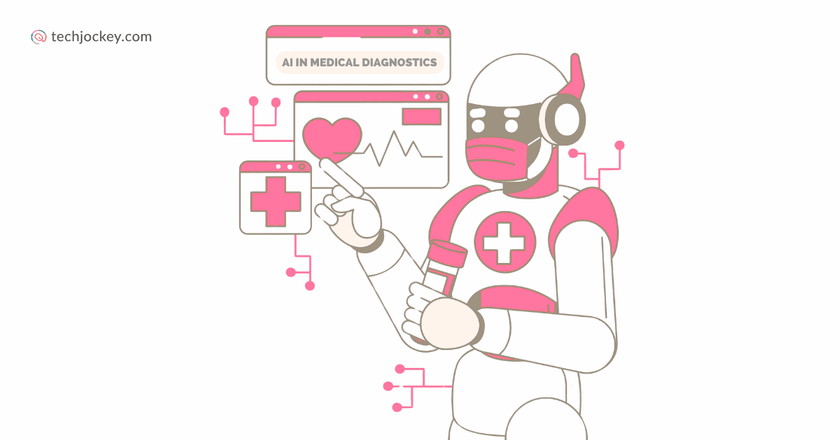How AI in Medical Diagnostics Is Helping Detect Diseases Earlier?

When it comes to an ailing person, what could matter more than a timely diagnosis? Well, nothing we can think of! For early disease detection not only makes treatments more manageable, but it also ends up saving more lives than one can think of.
However, when the responsibility of diagnosing health issues falls solely on doctors, the chances of human error and missed signs increase manifold. This is where AI in medical diagnostics plays a crucial role.
For artificial intelligence, as a form of advanced computer program, helps doctors detect illnesses sooner and more precisely. How exactly? Let’s deduce…
The Rise of AI in Medical Diagnostics
The concept of artificial intelligence isn’t something novel, but its introduction to the healthcare industry has become a true turning point. A decade ago, physicians were mainly relying on their experience and physical examinations. Today, however, they are more inclined to implement digital tools powered by AI in medical diagnostics. And why not!
These systems are fed on large volumes of information whereby they pick up patterns that humans may, at times, fail to detect. Besides, unlike humans, AI never gets tired and is capable of analyzing information in real-time, all of which makes it a useful companion in the world of medicine.
For instance, AI can detect a small mark on an X-ray of the lung that a physician might miss otherwise. This capability was particularly evident during the COVID-19 pandemic when hospitals had to deal with patients like never before. For that’s when AI stepped in to analyze scans and assist in the discovery of COVID cases, depicting just how useful AI diagnostics could be during a crisis.
Owing to which, today, the global market for AI in medical diagnostics is valued at $1.77 billion. If predictions are to be relied upon, it would reach $7.41 billion by 2030. This rapid growth sheds light on the increasing trust in AI diagnostics, as more and more hospitals and clinics switch to AI for disease diagnosis.
Ways in Which AI in Medical Diagnostics Helps Detect Diseases Earlier
AI in medical diagnostics is making a difference in numerous ways, as listed below…
- Faster & More Accurate Image Analysis
Medical imaging, in the form of X-rays, MRIs, and CT scans, is crucial for diagnosing many conditions. These images are, however, a little too complex to interpret. This is where AI in medical diagnostics stands out. For it can analyze these medical images in a matter of seconds, helping physicians identify tumors, fractures, or infections with great accuracy.
For instance, Philips’ CT 5300 is an AI-powered CT system that helps doctors detect abnormalities quickly and accurately.
- Early Cancer Detection
The presence of AI in medical diagnostics has proven to be the most promising when it comes to early cancer detection. For, by analyzing images and patient data, AI can identify cancerous growths way before symptoms even begin to appear. Some AI models can, in fact, detect lung and breast cancer with great accuracy.
As an example, the QAi Prostate tool, developed by Qritive, aids physicians in identifying prostate cancer in its early stages. Studies also show that such AI diagnostics tools have the potential to increase the accuracy of breast cancer diagnosis by up to 12%, saving thousands annually.
- Heart & Brain Disease Detection
AI is also succeeding in detecting heart and brain diseases. AI can detect blockages and other abnormalities in the heart scans that could be an indication of cardiovascular issues. It is also capable of reading brain images to identify a stroke or determine the likelihood of a heart attack occurring thus enabling doctors to be able to intervene in time.
Arterys is a leading example of a company using AI diagnostics to analyze heart and lung images. The company has received $28 million investment to scale its AI tools, demonstrating how confident people are in this technology.
- Continuous Health Monitoring
AI-powered wearable devices are changing the way individuals manage their health. The gadgets monitor heart rate, blood sugar, physical activity, and other vital signs and raise an alarm when something seems off.
Modern smartwatches, for instance, are capable of tracking irregular heartbeats and informing the wearer to consult a physician. AI in wearables is, as a result, growing at a tremendous rate, allowing people to become more and more proactive in respect to their health.
- Predictive Analytics
Since AI is capable of analyzing historical data, it is better positioned to foresee future health issues. For example, AI, by analyzing the medical history of a patient, can predict if they are at the risk of getting kidney disease, so doctors can take all the necessary preventive measures in time.
In the United States, AI-driven predictive analytics have contributed to a significant reduction in suicides among high-risk veterans, showcasing the potential of AI for disease diagnosis in improving outcomes across sundry health conditions.
- Reducing Doctor Workload
Physicians are usually overworked, and this may result in burnout and mistakes. With AI in medical diagnostics taking over routine procedures like image analysis and report generation, however, doctors get to concentrate more on their patients, minimizing the chances of error.
This is exactly why Siemens Healthineers has partnered with Ohio State Wexner Medical Center to implement AI-based diagnostic solutions, helping doctors work more efficiently and accurately.
- Managing Infectious Diseases
AI in medical diagnostics is also useful in managing the spread of infectious diseases like tuberculosis and HIV. In the case of tuberculosis, AI can analyze chest X-rays and detect the presence of the infection. And in the case of HIV, on the other hand, it can predict disease progression and identify co-infections. With these features, doctors can start treating the patient earlier, resulting in better outcomes.
- Improving Pathology & Lab Results
AI is increasingly being used in laboratories to analyze tissue samples and blood tests. In 2024, Roche partnered with PathAI to develop AI-based pathology software that assists pathologists in identifying diseases in a timely and efficient manner. This collaboration highlights how AI can enhance the precision and efficiency of laboratory diagnostics.
- Supporting Telemedicine & Rural Health
AI is also playing a critical role in expanding access to healthcare, particularly in remote and rural areas. By integrating with telemedicine software, AI enables people in these regions to receive timely diagnoses.
For example, NURA, an AI-focused health screening center launched in India in 2024, screens up to 50 people daily using advanced diagnostic tools. This initiative demonstrates how AI when used for disease diagnosis can bridge gaps in the availability of healthcare to all.
- Personalized Medicine
AI can support personalized medicine, using genetic information, medical images, and patient histories to provide individually tailored treatment. For example, AI can evaluate the genetic makeup of a patient and forecast the effectiveness of various medications, making sure that the right treatment is administered to the right individuals at the right time.
Future of AI in Disease Detection
The future of AI in medical diagnostics looks as promising as it gets. As technology continues to advance, more and more hospitals are projected to adopt AI solutions, with several key trends shaping the future of this field. Some of them are mentioned below for your understanding…
- More Personalized Medicine: AI will be increasingly employed in creating treatment strategies based on the specifics of each patient, such as gene pool and health history.
- Better Healthcare Software: Advancements in healthcare software will make AI tools more accessible and user-friendly, merging AI into everyday clinical use.
- Faster Diagnosis: AI will further speed up the diagnosis process, letting physicians make smart decisions faster and with more confidence.
- Wider Access: The use of AI for disease diagnosis would become more and more common. Owing to which, rural populace too would get to avail the benefits of early disease detection, especially with help from telemedicine and mobile health apps.
Conclusion
AI is revolutionizing healthcare by enabling early detection of diseases. As the sector continues to evolve thus, people can expect faster checkups, personalized treatments, and better ways to stay healthy before problems start.
Yashika Aneja is a Senior Content Writer at Techjockey, with over 5 years of experience in content creation and management. From writing about normal everyday affairs to profound fact-based stories on wide-ranging themes, including environment, technology, education, politics, social media, travel, lifestyle so on and so forth, she... Read more




























